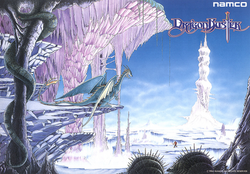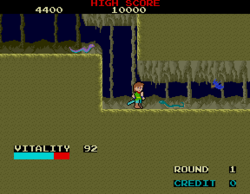Software:Dragon Buster
| Dragon Buster | |
|---|---|
 Sales flyer | |
| Developer(s) | Namco |
| Publisher(s) | Namco |
| Composer(s) | Yuriko Keino |
| Series | Dragon Buster |
| Platform(s) | Arcade, Family Computer, MSX, PC-8801, PC-9801, X68000, Mobile phone |
| Release | |
| Genre(s) | Platform, dungeon crawl, action role-playing |
| Mode(s) | Single-player |
| Arcade system | Namco Pac-Land |
Dragon Buster[lower-alpha 1] is a platform, action role-playing dungeon crawl game developed by Namco and released in 1984.[3][4] It runs on Namco Pac-Land hardware, modified to support vertical scrolling. In Japan , the game was ported to the Family Computer (Famicom), MSX, and X68000; the latter version was later released for the Virtual Console in the same region on November 18, 2008. Dragon Buster has been ported for the PSP and is available as part of Namco Museum Battle Collection. It was followed by a Japan-only Famicom sequel, Dragon Buster II: Yami no Fūin, and was later followed by the PlayStation game Dragon Valor, which was both a remake and sequel.
The game has side-scrolling platform gameplay and an overworld map similar to the later platform games for home consoles and personal computers.[5] Dragon Buster was also the earliest game to feature a double jump mechanic,[6] and one of the first to use a visual health meter.[3]
Plot
In an unnamed kingdom (known as Raxis in Dragon Valor), legend tells of a brave warrior who will rescue the land from the wrath of a fearsome dragon.[7] Clovis, the son of the royal family's chief bodyguard, is a young swordsman who was sent to live and train with a monk in the forest as a youth due to mischievous behavior in his childhood. The kingdom's legend comes to light as a dragon and his minions raid the land and kidnap King Lawrence's 16-year-old daughter, Princess Celia. Clovis learns he is the hero foretold by the legend, and sets off for Dragon Mountain to rescue Celia, slay the dragon and restore order to the land.
Gameplay
The player must guide the hero Clovis through each round on to the castle to rescue his beloved Princess Celia. There are multiple Princess Celias in the game, one in every few castles. The goal is to reach the true Celia at the end of the game in the final castle. Celia wears a different outfit each time she is rescued. As the player progresses through the round, he or she must choose various paths to take on to the castle. There are many paths to choose from and the number of these increases as the player gets to the higher rounds. The paths take the player to the individual levels of the round. There are multiple bosses on each level and many less powerful enemies scattered throughout each level. The player must find the boss that contains the exit on each level to proceed through the round and finally reach the castle. Clovis's vitality restores itself by 25% after each level is completed. The game ends when Clovis' vitality reaches zero.
There are five different types of levels: The Cave, The Tower, The Boneyard, The Mountain and The Ruins. Each of these levels boasts more of a particular type of monster than the others. For example, The Boneyard contains more of the boss Skeleton. The Cave is a mostly linear type of level, with mostly descents and horizontal movement. It boasts many bats and snakes. The Tower is notable for having many floors, and the player must do a lot of climbing in this type of level. The Boneyard is probably the most difficult type of level for having many enemies and paths to choose, and the player will most likely end up defeating every boss in the level before finding the boss that contains the exit. The Mountain has the player descend from the top of the mountain. The Ruins is a standard type of level with a bit of everything the other four types of levels contain. Finally, there is the Castle at the end of each round. Every Castle is the same, starting with a very long drop that takes the player to the Dragon's room to fight the Dragon.
Ports
When the game was ported to the NEC PC-8801 computer by Enix, the port featured an introduction to the game and an entirely new ending, featuring cinema screens depicting a battle-torn Clovis and a teary-eyed Celia. Dragon Buster was also included as a hidden mini-game in Tales of the Abyss for PlayStation 2 and Nintendo 3DS . It was included in various Namco Museum compilations including Namco Museum Volume 2 for the original PlayStation, Namco Museum Battle Collection for PlayStation Portable, and Namco Museum Virtual Arcade for Xbox 360. On December 9, 2021, Hamster announced that the emulated version is scheduled to be released for the Nintendo Switch and PlayStation 4 as part of the Arcade Archives line of digital releases.
Reception
Dragon Buster was a hit in Japan,[1] where Game Machine listed it on their March 1, 1985 issue as being the third most-successful table arcade unit of the month.[8] Computer + Video Games liked the game's ease to newcomers and colorful graphics, saying it stood out from other arcade games at the time.[1]
Notes
References
- ↑ 1.0 1.1 1.2 "Arcade Action: Dragonbusters!". Computer + Video Games (United Kingdom: EMAP) (44 (June 1985)): 90. 16 May 1985. https://solvalou.com/arcade/reviews/215/584. Retrieved 16 December 2019.
- ↑ "Dragon Buster (Registration Number PA0001372500)". https://cocatalog.loc.gov.
- ↑ 3.0 3.1 "Gaming's most important evolutions". GamesRadar. Oct 8, 2010. p. 4. http://www.gamesradar.com/f/gamings-most-important-evolutions/a-20101008102331322035/p-4. Retrieved 2011-03-29.
- ↑ Dragon Buster at the Killer List of Videogames
- ↑ "Dragon Buster". https://www.allgame.com/game.php?id=9953.
- ↑ Reeves, Ben (2014-11-04). "An Ode To The Most Important Power-Up: Double Jump". Game Informer. http://www.gameinformer.com/b/features/archive/2014/11/04/an-ode-to-the-double-jump.aspx. Retrieved 2014-11-26.
- ↑ Story of Dragon Buster text in Namco Museum Vol. 2
- ↑ "Game Machine's Best Hit Games 25 - テーブル型TVゲーム機 (Table Videos)". Game Machine (Amusement Press, Inc.) (255): 21. 1 March 1985.
External links
 |


